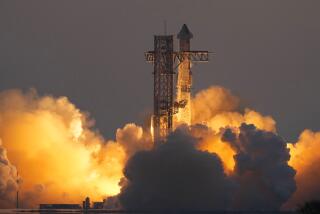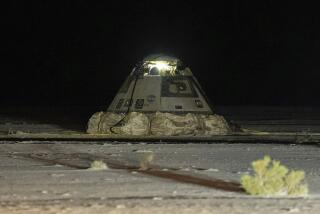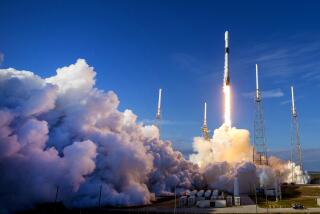A Nightmare Option at NASA: Emergency Return to Launch Site
- Share via
KENNEDY SPACE CENTER, Fla. — The first hint of trouble came when space shuttle Columbia’s three main engines roared to life 6.6 seconds before liftoff in February.
Inside the cockpit, commander Andrew Allen and pilot Scott Horowitz watched in dismay as the gauge for the left engine showed inadequate thrust. Here comes a launch-pad abort and three-week flight delay, they muttered.
But the engines kept firing and, when the countdown reached zero, the rocket boosters ignited--to the astronauts’ shock. The gauge still was showing 45% power for the left engine, less than half what it’s supposed to be. What’s more, an amber caution light came on.
Allen’s call to Mission Control, 24 seconds into the flight, stunned those who heard it.
“Gauge showing 45% on the left,” Allen radioed.
Eleven seconds passed--11 long, nerve-racking seconds--before Mission Control replied: “Columbia, we’re showing good engines, good commands on all three.”
Whew, false alarm.
Until then, Allen, Horowitz and the five other men aboard Columbia did not know whether they would soar into orbit to unreel a satellite on a cord or attempt a dangerous, possibly deadly, return to the Kennedy Space Center.
No one has ever attempted a return to launch site, known in space shuttle circles as RTLS. No one wants to.
It goes something like this:
One or more of the three main engines shuts down during the first three or four minutes of flight, or some other critical system fails, and Mission Control orders an RTLS. Nothing can be done until the two solid-fuel rocket boosters finish burning and peel away two minutes into the flight; the pilots then push the abort button.
The shuttle continues to ascend in a normal position, by computer command, as the good engines burn off fuel in the attached tank. Then comes the scary part: The shuttle does a 180-degree flip and starts flying backward, away from Cape Canaveral, at up to six times the speed of sound, or Mach 6.
Engines serve as a brake until the external fuel tank is almost empty. The shuttle, sinking as its velocity drops to zero, begins accelerating back toward the cape, dumps the tank, and glides toward the 15,000-foot runway at Kennedy.
If all goes well--a big if--the shuttle should be back on the ground 25 to 30 minutes later.
“There are various places where, if things didn’t go just right, you could get into bad situations for flight control to recover from,” says shuttle commander-turned-manager Loren Shriver. “Those things are all part of the risk of conducting this kind of a business.”
Where the shuttle lands, and whether it lands in one piece, has long been a matter of debate. Astronauts might have to bail out over the Atlantic and ditch the spaceship if another engine failed.
Some say bringing a crew and crippled shuttle safely back to Kennedy under such circumstances cannot be done, that it’s “just something to keep you busy while you’re waiting to die,” says former astronaut Michael McCulley, an aerospace company executive. “I don’t know what the answer is,” he adds.
NASA technical director John Young, a moon-walker who commanded the first shuttle flight in 1981, has warned for years that it would take a couple of miracles and acts of God for an RTLS to succeed. His pilot on that first shuttle mission, Robert Crippen, offered to try an RTLS on a subsequent flight, but the National Aeronautics and Space Administration refused.
Shriver admits that an RTLS is the riskiest emergency landing by far and too dangerous to test in flight. But he says it should work based on computer models and simulations.
Allen, a 40-year-old Marine and former test pilot, had practiced the maneuver in shuttle simulators on the ground at least once a week in the year leading up to Columbia’s launch on Feb. 22--NASA’s 75th shuttle flight.
“Procedurally, it’s not an overly difficult thing to do,” Allen said, “even though just the aerodynamics of thinking what it would be to fly backward with a lot of [engine] plume coming up, and to go to a zero velocity pointed in the wrong direction and then start flying back toward the cape, is something I guess I’d prefer not to be the first person to try.”
In its annual report, issued a week after Columbia’s launch, the independent Aerospace Safety Advisory Panel criticized NASA for its “unusual and demanding” RTLS procedure, which it said was “fraught with potential for error in a high-stress abort situation.”
There are other emergency options if a main engine fails later in the 8 1/2-minute climb to orbit, all of them considered safer than an RTLS: limping across the Atlantic to a NASA-staffed runway in Spain or Morocco, slipping into a lower-than-intended orbit and possibly continuing the mission, or, least likely of all, circling Earth once and landing at the first opportunity at Edwards Air Force Base in California, White Sands Missile Range in New Mexico or Kennedy.
There has been only one instance of any of this, in 15 years of shuttle flight.
After the premature shutdown of an engine in 1985, Challenger made it to a 195-mile-high orbit, 46 miles lower than planned, but high enough to complete an eight-day science mission.
Six months later, Challenger exploded 73 seconds after liftoff because of a booster rocket leak, killing all seven crew members. There was no time, or means, to escape in such an accident.
The chances of both an engine gauge and caution light failing are so slight--maybe 2 in 1 million--that there’s no need to revamp the system, Allen says. His mission’s erroneous light has been traced to a computer-sequence snag; engineers have yet to determine why the gauge malfunctioned.
Allen says the flight proved one thing, what with the engine scare and the sudden break of a 12-mile electrical cable that resulted in the loss of a tethered satellite:
“Our flight doctors take a good, hard look at all of this a lot, so I’ve got a good checkout of my adrenaline glands in this flight, and there’s no doubt that they work.”
(BEGIN TEXT OF INFOBOX / INFOGRAPHIC)
Emergency Options
NASA’s four options for an emergency shuttle landing shortly after liftoff:
* Return to Launch Site: Main engine fails between liftoff and three to four minutes into flight. Shuttle eventually flips and does U-turn, gliding back to Kennedy Space Center within 25 to 30 minutes. Riskiest option.
* Transoceanic-Abort Landing: One or more engines fail between 2 1/2 minutes and eight minutes into flight. Shuttle crosses Atlantic and lands at NASA-staffed runways in Spain or Morocco within 40 to 45 minutes.
* Abort-to-Orbit: Engine fails five minutes or more into flight. Shuttle reaches lower-than-planned orbit and stays up, if possible, for entire mission.
* Abort-Once-Around: Engine fails late in 8 1/2-minute ascent and shuttle cannot reach viable orbit, or there is cabin leak or other major systems problem necessitating quick return. Shuttle circles Earth and lands within 90 minutes at Edwards Air Force Base, Calif., White Sands Missile Range, N.M., or Kennedy Space Center. Least likely option.
Associated Press
More to Read
Sign up for Essential California
The most important California stories and recommendations in your inbox every morning.
You may occasionally receive promotional content from the Los Angeles Times.










